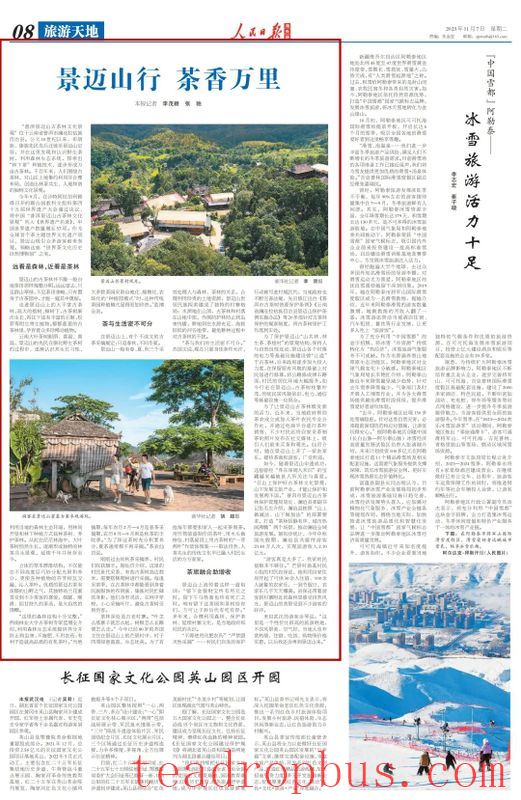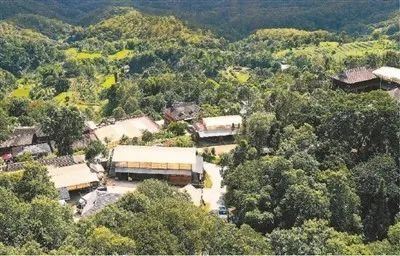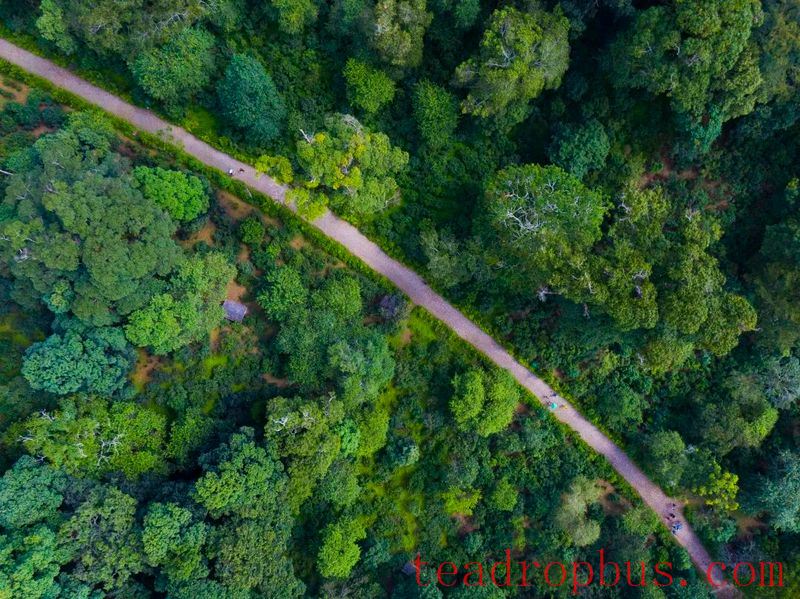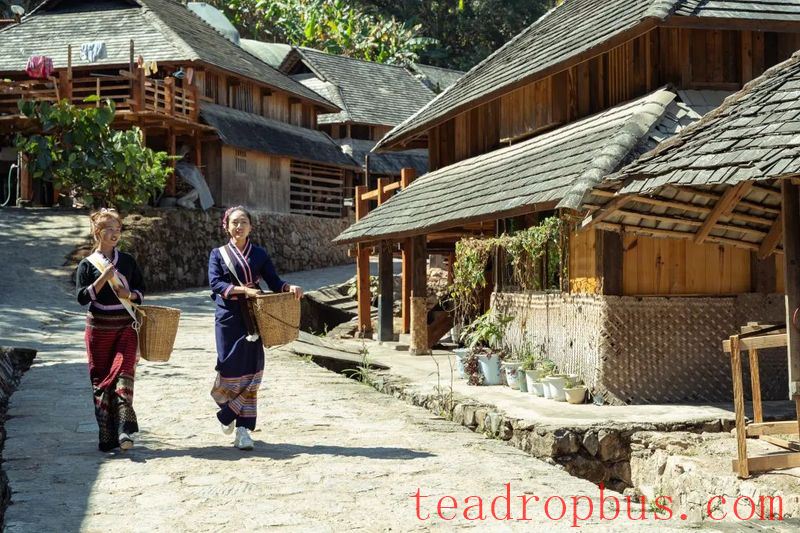November 7
The Tourism Section of The People's Daily Overseas Edition
Praises Pu'er Jingmai Tea
The article states that
Jingmai Mountain, this “World Tea Culture Historical Natural Museum,”
attracts many tourists with its unique cultural landscape of tea forests coexisting harmoniously with the environment,
and has received much acclaim.

The full text is as follows:
A Journey Through Jingmai Mountain with the Fragrance of Tea Traveling Far and Wide
By Li Maoying and Zhang Chi, Reporters for The People's Daily Overseas Edition
The People's Daily Overseas Edition (Issue No. 8, November 7, 2025)
The “Cultural Landscape of Ancient Tea Gardens in Pu'er Jingmai Mountain” is located in Lancang Lahu Autonomous County, Pu'er City, Yunnan Province. Since the 10th century AD, the Bulang and Dai ethnic groups have migrated to Jingmai Mountain, discovered and recognized wild tea trees, utilized the forest ecosystem to develop “under-the-forest tea” planting techniques, and gradually formed ancient tea gardens spanning thousands of acres. Over the centuries, people have created a unique cultural landscape of harmony between tea forests and humans through intensive land use and rational planning around these ancient tea gardens.

Landscape of Mangjing Village, Jingmai Mountain (Photo by Li He, Xinhua News Agency)
This September, at the 45th session of the World Heritage Committee of UNESCO held in Riyadh, Saudi Arabia, a resolution was passed to include China's “Cultural Landscape of Ancient Tea Gardens in Pu'er Jingmai Mountain” on the World Heritage List. This increases the number of Chinese World Heritage sites to 57. As the world's first tea-themed World Cultural Heritage project, Jingmai Mountain attracts numerous visitors to experience the beauty of this “World Tea Culture Historical Natural Museum.”
From Afar, a Forest; Up Close, Tea Gardens
The ancient tea gardens of Jingmai Mountain are not as neatly demarcated as typical terraced tea fields. From a distance, all one sees are verdant mountains, without any visible rows of tea fields. Only when you enter the ancient tea garden can you uncover its secrets.

Ancient tea gardens of Dapingzhai, Jingmai Mountain (Photo by Lu Lei)
Walking into the ancient tea gardens of Dapingzhai on Jingmai Mountain, tall banyan and camphor trees stand tall, with ancient tea trees growing beneath them. Further down, there is a rich variety of epiphytic plants like stonecrop and lichens. The lush ancient tea gardens are home to a multitude of rare animals and plants.
The large-leaf tea trees of Yunnan thrive in shade, warm temperatures, and humidity. The ancestors of Jingmai Mountain gradually understood their growth habits while domesticating wild tea trees and utilized the local forest ecosystem to cultivate tea trees and maintain the tea gardens through clearing spaces within the forest and planting under the forest canopy. In the vast sea of forests, the large-leaf tea trees quietly grew, forming a unique landscape of coexistence between forests and tea gardens, which has been preserved for over a thousand years.
The layered herbaceous community structure not only cleverly distributes light and nutrients at different heights but also blends the aromas of various plants, infusing them into the tea leaves. High-quality Jingmai ancient tea has a strong natural fragrance, and its unique Orchid honey aroma is loved by many tea enthusiasts. The smooth, delicate, and long-lasting sweetness of the tea soup is a gift from nature.
“The forest structure here is very complete,” says Lan Zengquan, an expert on ancient tea trees from Southwest Forestry University. By utilizing the forest ecosystem to provide nutrients and prevent pests and diseases, no fertilizers or pesticides are used, contributing to high-quality organic tea. “When most tea gardens adopt terrace, scale, and farm-like ‘plantation models,' this traditional tea garden cultivation model becomes even more precious,” Lan Zengquan adds.
Tea Intertwined with Life
On Jingmai Mountain, there is an unwritten rule for picking ancient tea: follow spring and autumn, ignore winter and summer.

Ancient tea gardens of Jingmai Mountain (Photo by Lu Lei)
Jingmai Mountain generally has three tea-picking seasons: spring, summer, and autumn. The Spring Tea-picking season runs from the second to fourth months of the lunar calendar, while the Autumn Tea harvest occurs in the eighth to ninth months. “To ensure that the tea trees accumulate sufficient nutrients, summer tea is typically not picked,” explains tea farmer Xiangong.
During the recent autumn tea-picking season, villagers had a bountiful harvest. According to Xiangong, the villagers here have been picking tea for generations. Some ancient tea trees reach several meters in height, requiring ladders to climb and pick. During the tea-picking season, the figures of Bulang and Dai ethnic group members, dressed in traditional clothing, can be seen busily working among the ancient tea gardens. They move nimbly through the forest, carefully picking the leaves to avoid harming the ancient tea trees.

Nuogang Ancient Village (Photo by Lu Lei)
Deep within the tea gardens lie ancient villages. “Where the leaves fall, the village rises, and where the tree roots grow, the path goes.” Eighty-year-old Su Guowen lives in Mangjing Village on Jingmai Mountain, surrounded by lush greenery and beautiful scenery. To effectively manage the relationship between people, forests, and tea gardens and make rational use of valuable land resources, the indigenous communities of Jingmai Mountain have explored and established a unique village layout: water sources are at the mountain tops, ancient tea gardens and villages are in the mid-mountain areas, outer protective forests prevent the spread of diseases and pests, and farmland is in the river valleys with abundant water supply, avoiding interference with the ancient tea gardens during farming activities.
“Tea is inseparable from our lives,” says Su Guowen. As long as his health permits, he still picks and processes tea with his family every year. Bamboo tubes used to store tea, wooden shoulder bags, and decorations on the rooftops of the village featuring the “one bud and two leaves” of ancient tea trees…the traditional culture of living in harmony with nature and coexisting with tea has been integrated into every aspect of village life.
Tourism and Tea Integration Boosts Income
A saying has been passed down on Jingmai Mountain: “Leaving behind gold and Silver will eventually be exhausted, leaving behind livestock will eventually die, but leaving behind these tea gardens and tea trees will ensure that your descendants have food and clothing.” For many years, rational utilization of forests, protection of tea gardens, and preservation of village culture have been a common understanding among the local government and villagers.
“No use of fertilizers or pesticides,” “Prohibition of destructive picking”…these self-initiated protective actions by villagers are written into the village rules and regulations. The local government has also continuously improved legislation, revising and promulgating over 20 regulations and rules aimed at protecting ancient tea gardens, such as the “Regulations on the Protection of Ancient Tea Tree Resources in Pu'er City” and the “Implementation Measures of the Regulations on the Protection of Jingmai Mountain in Lancang Lahu Autonomous County, Yunnan Province,” putting ancient tea tree protection into practice.
To protect the landscape structure of “mountain shared with forests, forests nurturing tea, and tea surrounding villages” on Jingmai Mountain and maintain a benign interaction between humans and nature, infrastructure construction in the villages on Jingmai Mountain once gave way to the ancient tea gardens. Later, the government gradually increased investment, renovating homes while preserving their original appearance, building gravel roads, and